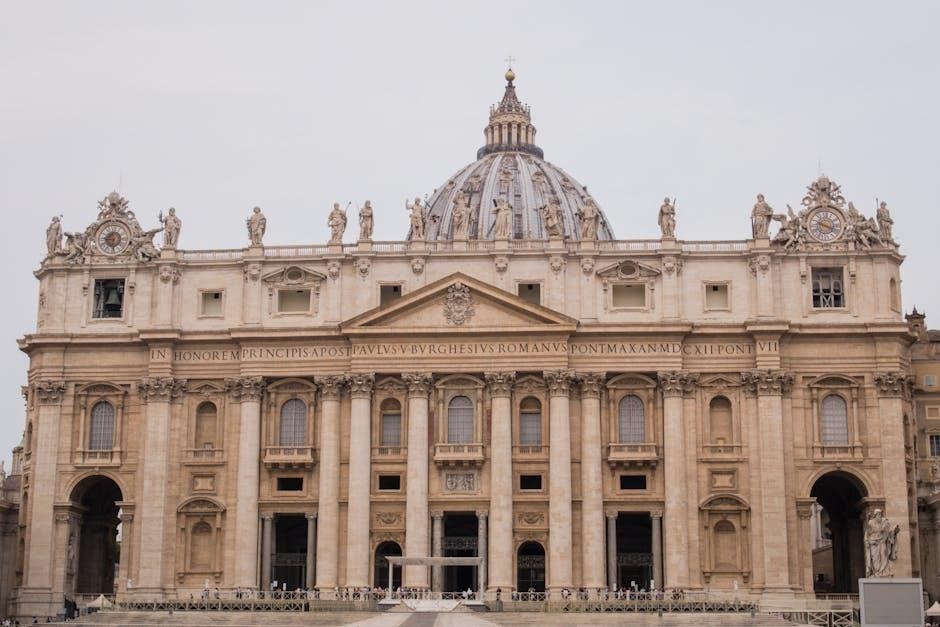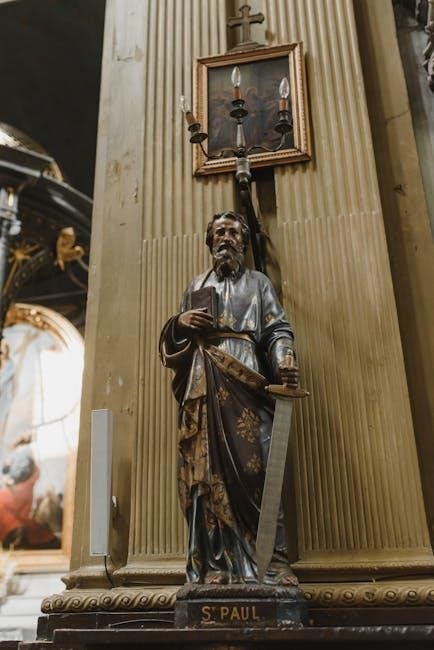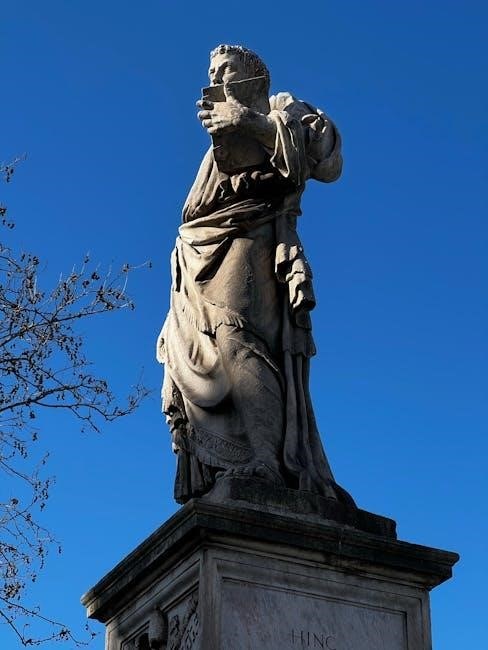Apostle Paul Biography PDF: An Overview
Explore the life of Apostle Paul through a comprehensive biography PDF. Delve into his origins, conversion, missionary journeys, theological contributions, and eventual martyrdom. Discover his profound influence on Christianity’s development and lasting legacy, shaping the New Testament.
Apostle Paul, originally known as Saul of Tarsus, stands as a monumental figure in early Christianity. Born around the same time as Jesus, he significantly shaped the faith through his missionary work and theological insights. His life, chronicled in the Book of Acts and his own epistles, reveals a transformative journey from persecutor to passionate advocate for Christ. Paul’s influence extends to the New Testament, where his letters offer profound guidance on Christian living and doctrine.
His writings, though debated in authorship, remain central to Christian theology, addressing key themes like salvation, grace, and the relationship between Jews and Gentiles. Paul’s dedication to spreading the Gospel across the Roman world, often facing hardship and persecution, solidified his place as one of the most important figures after Jesus in the history of Christianity, leaving an enduring legacy.

Early Life and Background
Examine Paul’s formative years, born in Tarsus, a city of Cilicia. Explore his unique status as both a Jew and Roman citizen, and discover the education and trade that shaped his early identity.
Birth and Origins in Tarsus
Paul, initially known as Saul of Tarsus, was born around 4 BCE in the city of Tarsus, located within the Roman province of Cilicia (modern-day Turkey). Tarsus was a prominent Hellenistic city, a center of learning and commerce, influencing Paul’s early life and worldview. His upbringing in a multicultural environment exposed him to both Jewish traditions and Greco-Roman culture.
Details of Paul’s family are limited, but it is known that he was a Jew. His birthplace, not the land Christ walked but the Hellenistic city of Tarsus; This unique blend of cultures shaped his perspective, preparing him for his future role as an apostle to the Gentiles.
Tarsus was a melting pot of ideas, languages, and customs, contributing to Paul’s broad understanding of the world, that would later serve him well in his missionary journeys.
Citizenship and Education
Apostle Paul possessed Roman citizenship, a significant advantage that offered him legal protections and privileges throughout the Roman Empire. The acquisition of his citizenship is not explicitly detailed, it is speculated to be by birth. This citizenship proved invaluable during his missionary journeys and trials, allowing him to appeal to Roman courts and avoid certain punishments.
Paul was a Greek-speaking Jew from Asia Minor. He received a comprehensive education, evident in his mastery of the Hebrew Scriptures and his familiarity with Greek philosophy and rhetoric. He demonstrated his adeptness in Jewish law and traditions, reflecting his Pharisaical background.
His letters, written in Koine Greek, suggest a solid grasp of language and communication, enabling him to articulate complex theological concepts effectively. His education equipped him with the skills necessary to engage diverse audiences.
Occupation and Trade
Beyond his religious pursuits, Apostle Paul practiced a practical trade: tent making. This was not merely a side job but an integral part of his ministry, enabling him to support himself and avoid being a financial burden on the communities he served. He mentions working with his own hands in his letters, emphasizing the value of self-sufficiency and hard work.
Tent making was a common trade in Tarsus, Paul’s birthplace, providing him with a valuable skill applicable across the Roman world. This allowed him to travel with basic tools, setting up shop wherever he went.
His trade facilitated his missionary journeys, granting him independence and demonstrating his commitment to serving others. It also connected him with the common people, fostering relationships and opening doors for sharing his faith. This trade gave him a unique perspective.

Conversion and Transformation
Apostle Paul’s life took a dramatic turn with his conversion. This pivotal moment reshaped his beliefs and redirected his purpose, transforming him from a persecutor of Christians into a devoted apostle, spreading the Gospel.

The Damascus Road Experience
The Damascus Road experience marks the turning point in Paul’s life, forever altering his path and solidifying his role as a pivotal figure in Christian history. Before this transformative event, Paul, known as Saul of Tarsus, actively persecuted followers of Jesus, driven by his unwavering devotion to Jewish law and tradition. His journey to Damascus was intended to further this persecution, seeking out and apprehending Christians in the city.
However, as Paul neared Damascus, a blinding light flashed around him, accompanied by a voice he identified as Jesus. This encounter shattered his previous convictions, leaving him temporarily blind and profoundly shaken. The experience challenged his understanding of God’s plan and the identity of Jesus.
This divine intervention led to Paul’s conversion, marking the beginning of his transformation from a persecutor to a fervent advocate of Christianity. The Damascus Road experience not only changed Paul’s beliefs but also ignited his passion to spread the Gospel, shaping the course of early Christianity.
Initial Reactions and Immediate Aftermath
Following the transformative Damascus Road experience, Paul faced a period of confusion and uncertainty. Blinded by the encounter with Jesus, he was led to Damascus, where he remained for three days without sight or food. This period allowed for introspection and processing of the profound event that had just occurred.
News of Paul’s experience and conversion spread quickly, eliciting mixed reactions. Some were skeptical, finding it difficult to believe that the former persecutor had become a follower of Christ. Others were wary, fearing that it was a trick. However, some Christians, like Ananias in Damascus, cautiously approached Paul, laying hands on him and restoring his sight.
After regaining his sight, Paul spent time in Damascus, initially grappling with his newfound faith and reevaluating his understanding of scripture. He then ventured into Arabia, possibly Coele-Syria, for a period of reflection. Upon returning to Damascus, he began to preach in the synagogues, proclaiming Jesus as the Son of God, astonishing those who once knew him as a persecutor.

Missionary Journeys and Ministry
Apostle Paul embarked on extensive missionary journeys, spreading the Gospel across the Roman world. His ministry involved establishing churches, teaching new believers, and facing numerous challenges while proclaiming the risen Christ.
First Missionary Journey
Paul’s first missionary journey, documented in the Book of Acts, marked a pivotal moment in spreading Christianity beyond its Jewish origins. Accompanied by Barnabas and John Mark, Paul ventured from Antioch, a prominent city in Syria, to Cyprus. Their mission commenced in Salamis, where they proclaimed the Gospel in synagogues, reflecting Paul’s initial approach of reaching Jewish communities first.
From Cyprus, they sailed to Perga in Pamphylia, where John Mark departed, creating early tensions within the group. Undeterred, Paul and Barnabas continued to Antioch in Pisidia, a region in modern-day Turkey. There, Paul delivered a powerful sermon, outlining the history of Israel and presenting Jesus as the fulfillment of God’s promises.
The message resonated with many Gentiles, leading to significant conversions. However, opposition arose from Jewish leaders, who stirred up persecution against Paul and Barnabas, forcing them to leave the city. Despite the challenges, the first journey laid the groundwork for future missionary endeavors.
Second Missionary Journey
Paul’s second missionary journey, a significant expansion of his ministry, saw him venturing further into new territories. After a disagreement with Barnabas over John Mark, Paul chose Silas as his companion, embarking from Antioch. Their journey commenced through Syria and Cilicia, strengthening the churches in those regions.
Reaching Lystra, Paul met Timothy, a young disciple who became a trusted companion. Continuing through Phrygia and Galatia, they were divinely guided to Macedonia, a pivotal moment that opened the door to ministry in Europe. In Philippi, they established the first Christian community in Europe, facing opposition and imprisonment.
Undeterred, they traveled to Thessalonica and Berea, preaching and making converts before facing further persecution. Paul then arrived in Athens, engaging with philosophers at the Areopagus, presenting the Gospel in a culturally relevant way. This journey solidified Paul’s role as an apostle to the Gentiles, planting seeds of faith across diverse communities.

Third Missionary Journey
Apostle Paul’s third missionary journey, marked by consolidation and deeper engagement, began in Antioch. He traversed Galatia and Phrygia, strengthening the disciples. Ephesus became his central base for nearly three years, a period of intense ministry characterized by miracles and confrontations with local idol makers threatened by Christianity’s growing influence.
From Ephesus, Paul sent Timothy and Erastus ahead to Macedonia, later joining them. He traveled through Macedonia and Greece, encouraging believers. A plot against him in Corinth prompted a change of plans, leading him back through Macedonia.
He sailed to Troas, where he raised Eutychus from the dead after the young man fell asleep during a lengthy sermon. The journey culminated in Jerusalem, where Paul’s arrival stirred controversy, leading to his arrest in the temple. This marked a turning point, setting the stage for his imprisonment and eventual journey to Rome.

Theological Contributions and Writings
Explore Apostle Paul’s profound theological impact through his epistles. Uncover key themes like justification by faith, the body of Christ, and the Holy Spirit’s role, shaping Christian doctrine and practice.
Authorship of Pauline Epistles
Apostle Paul is traditionally credited with authoring thirteen books in the New Testament, known as the Pauline epistles. These letters form a cornerstone of Christian theology and provide invaluable insights into the early church’s beliefs and practices. However, scholarly debate surrounds the authenticity of all thirteen letters.
Seven epistles—Romans, 1 Corinthians, 2 Corinthians, Galatians, Philippians, 1 Thessalonians, and Philemon—are widely accepted as genuinely written by Paul himself. These letters reflect Paul’s personal experiences, theological convictions, and pastoral concerns. Their language, style, and content consistently align with what is known about Paul from other historical sources.
The remaining six epistles—Ephesians, Colossians, 2 Thessalonians, 1 Timothy, 2 Timothy, and Titus—are often referred to as Deutero-Pauline or Pastoral Epistles. Some scholars argue that these letters were written by Paul’s followers, possibly using fragments or themes from Paul’s teachings, after his death. These letters display differences in language, style, and theological emphasis compared to the undisputed Pauline epistles, raising questions about their direct authorship.
Key Theological Themes
Apostle Paul’s writings are rich with profound theological themes that have shaped Christian thought for centuries. Central to his theology is the concept of justification by faith, emphasizing that salvation is not earned through human works but received as a free gift through faith in Jesus Christ. This doctrine challenged traditional Jewish views of righteousness and paved the way for a more inclusive understanding of God’s grace.
Another key theme is the universality of salvation, extending God’s offer of redemption to both Jews and Gentiles. Paul argued that the dividing wall between these two groups had been broken down through Christ, creating a new community of believers united in faith. This emphasis on inclusivity was revolutionary in its time and continues to resonate with Christians today.
Paul also explored the nature of the church as the body of Christ, emphasizing the interconnectedness and interdependence of all believers. He taught that each member of the church has a unique role to play in building up the community and fulfilling God’s purposes.

Later Life, Imprisonment, and Death
Apostle Paul’s later years were marked by imprisonment in Rome, where he continued to preach and write. Ultimately, he faced martyrdom, leaving a lasting legacy of faith, perseverance, and devotion to Christ.

Imprisonment in Rome
Paul’s journey eventually led him to Rome, but not as a free missionary. He arrived as a prisoner, facing charges related to his teachings and perceived disruption of social order. Despite his confinement, Paul’s spirit remained unbroken, and he continued to minister to those around him. His imprisonment provided opportunities to reach guards, fellow prisoners, and visitors, spreading the gospel within the heart of the Roman Empire.
While incarcerated, Paul penned several epistles, including Philippians, Ephesians, Colossians, and Philemon. These letters, now part of the New Testament, offer profound theological insights and personal reflections on faith, love, and perseverance amid adversity. They reveal Paul’s unwavering commitment to Christ and his desire to encourage and strengthen the early Christian communities.
His imprisonment was a testament to his unwavering faith, and it further cemented his place in Christian history.

Martyrdom and Legacy
Paul’s life culminated in martyrdom in Rome, likely during the reign of Emperor Nero, around AD 62-64. Church tradition holds that he was beheaded, a death befitting his Roman citizenship. His execution marked the end of his earthly ministry, but the beginning of his enduring legacy.
Paul’s impact on Christianity is immeasurable. His writings comprise a significant portion of the New Testament, shaping Christian theology and practice for centuries. His missionary journeys spread the gospel throughout the Roman world, establishing churches and nurturing communities of faith. He is revered as one of the most influential figures in Christian history, second only to Jesus himself.
His teachings continue to inspire and challenge believers today; He remains a model of unwavering faith, tireless service, and profound theological insight. Paul’s legacy endures as a testament to the transformative power of the gospel.

